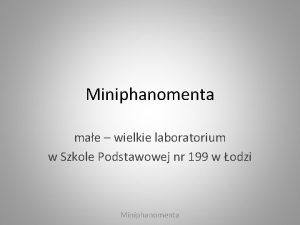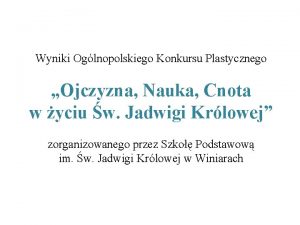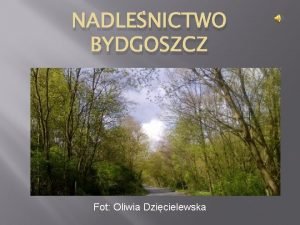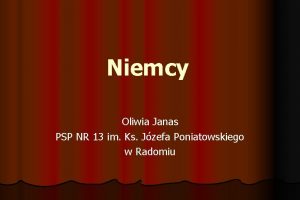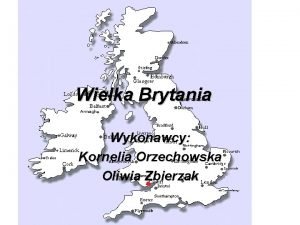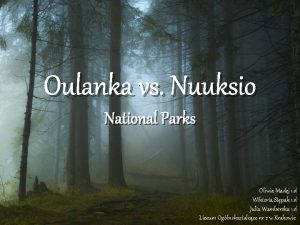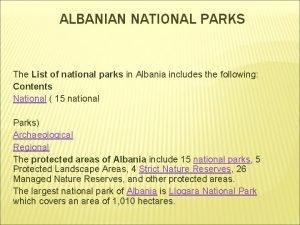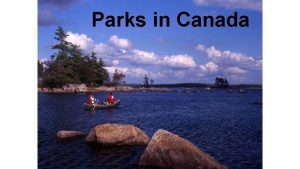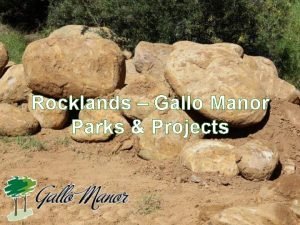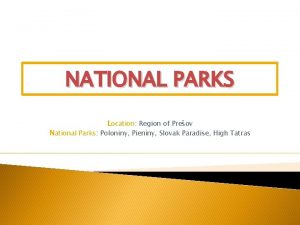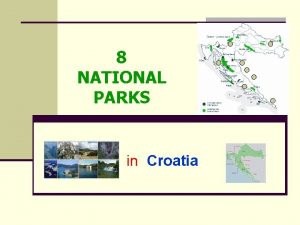Oulanka vs Nuuksio National Parks Oliwia Madej 1














- Slides: 14

Oulanka vs. Nuuksio National Parks Oliwia Madej 1. d Wiktoria Stępak 1. d Julia Wamberska 1. d Liceum Ogólnokształcące nr 2 w Krakowie

Oulanka National Park The Emblem of Oulanka National Park - Calypso Orchid

The Oulanka National Park is situated in Northern Ostrobothnia in Kuusamo and in Eastern Lapland in Salla. It represents nature in the zone of northern boreal forest. The heights of the terrain is between the lowes river valleys at 151 meters to the area's highest hills which reach to 380 metres above sea-level. The landscape is dominated by Scots Pine forests. Nestled in a bed of moss in that forest, grows the fragile orchid called calypso. It is a Oulanka National Park's floral emblem.

Oulanka is called "the National Park of flowing water". The area is traversed by two large rivers: Oulankajoki and Kitkajoki with several tributaries, such as the Rivers Maaninkajoki and Savinajoki, and many little brooks. The River Oulankajoki is the heart of Oulanka National Park. The waters originate from the Salla mires and the actual river begins at Lake Aittajärvi. It is a 135 kilometre-long river. The River Kitkajoki begins at Kiveskoski Rapids in Lake Ala. Kitkajärvi.

There are many rare species in Oulanka National Park. An ideal environment for a versatile range of species i created by the difference in temperature between the high rising fells and low river valleys. For example the park's emblem plant, the calypso, is threatened, but common in this area. Other endangered species that appear in Oulanka are pohjanailakki and lady's-slipper, Mountain Avens, arnicas and Tartar Catchflies.

Oulanka's herb-rich forests and broad mires make the National Park a superb habitat. The vegetation of the herb-rich forests is especially plentiful and lush. Some plants that grow in the area are the European baneberry, the Daphne, the Woodland strawberry and the Frog orchid. Dry herb-rich forest on the edges of Norway Spruce and Scot's Pine forests are emblematic of Oulanka National Park. Some species that appear in them are Dark Red Helleborine and Dwarf Milkwort. The diverse mires also have Marsh Saxifrage (Saxifraga hirculus) and mosses, which are rare.

Unfortunately, the National Park was victim of wild fires which have left their mark on the region's landscape and nature. Some of tree stumps bear black burn scars left by raging fires of the past. Even today small forest fires burn in the park occasionally. However rare species such as beetles benefit from fires.

The moose (Alces alces) and the half-time reindeer (Rangifer Tarandus) are the most common spices in the National Park. Small mammals are also typical in the area. There also large carnivores such as the bear. The wolf, wolverine (Gulo gulo) and lynx (Lynx lynx), are quite rare in the park. Birds which are common on the shores of flowing waters in Oulanka are the White-throated Dipper (Cinclus cinclus) and the Common Sandpiper (Actitis hypoleucos). Under the sky in that National Park flies the Golden Eagle (Aquila chrysaetos) and the White-tailed Eagle (Haliaeetus albicilla).

Nuuksio National Park The Emblem of Nuuksio National Park is Siberian Flying Squirrel.

Nuuksio National Park is situated in Uusimaa Region in the areas of Espoo, Kirkkonummi and Vihti. It is located in the border of the oak forest zone and the southern boreal forest zone. The scenery is dominated by valleys and gorges which were formed by the Ice Age, and barren rocky hills are covered by lichen and sparse pine forest. The highest hills reach only 110 metres above the sea level. The most threatened species are Woodlark (Lullula arborea) and the European Nightjar (Caprimulgus europeaus).

There are many picturesque places on the cliffs. On Haukankierros Trail there is a high rock which looked out to Brook Myllypuro valley in the northeast. The landscape changes with the seasons. In the autumn it shines with gorgeous colours. You can also see the Högbacka farm, which was built in 1930´s. These days serves as a preservation base for the National Park. In close proximity to Högbacka there is Giant's Kettle, which is the boundary mark between the towns Espoo and Vihti. These Giant´s Kettles were formed during the Ice Age by water making stones rotate around which made a deep hole in the rock.

The rocks descend vertically or little by little to damp gorges, which are dominated by moist forests, and spruce and pine mires. Under the cliffs, the dense trim forests are cool, damp and dim. On the base of the rocks and in the creek hollows full of nutrients, the vegetation is lavish. There grows the Alpine Currant (Ribes alpinum) and other currants, the European Honeysuckle (Lonicera xylosteum), the Mezereon (Daphne Mezereum), trees like the Hazel (Corylus avellana) and the Littleleaf Linden (Tilia cordata). In May the earth seems entirely blue and white with Liverleafs (Hepatica Nobilis) and the Wood Anemones (Anemone nemorosa). In the valleys chirp the Blackcaps (Sylvia atricapilla) and the Red-breasted Flycatchers (Ficedula parva). The Park is also a habitat of Flying Squirrels.

There are over 80 little lakes and ponds inside Nuuksio National Park. Some of the lakes have brown water and are surrounded by open bogs and someof them have clear water and rocky shores. There also many mires. The largest one is called Soidinsuo, which is in its natural shape and surrounded by old forest. Most parts of the National Park have been created by men, but some parts have already had a long time to develop into proper old-growth forest. The best old-growth forests can be found around Lake Haukkalampi and Brook Myllypuro on the slopes and the bottom of the dells. The turf floats of Lake Mustalampi are a unique feature of Nuuksio National Park.

Bibliography www. nationalparks. fi www. visitespoo. fi www. haltia. com www. nationalparks. fi en. wikipedia. org travel. nationalgeographic. com www. nationalmgeographic. pl
